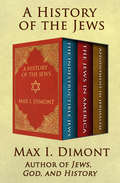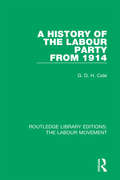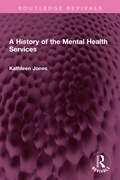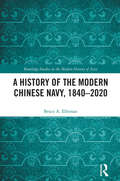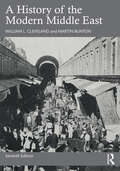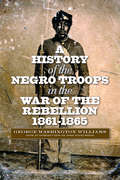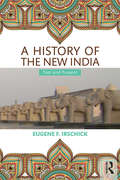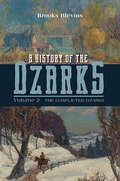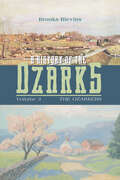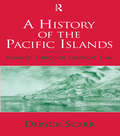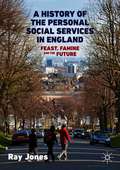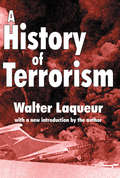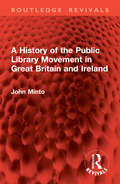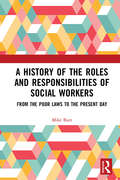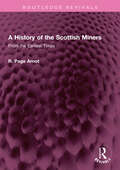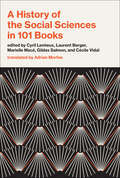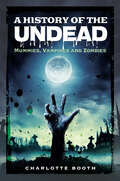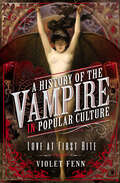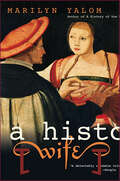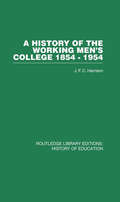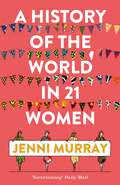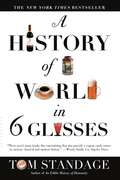- Table View
- List View
A History of the Jews: The Indestructible Jews, The Jews in America, and Appointment in Jerusalem
by Max I. DimontThree books on Jewish heritage from the author of Jews, God, and History, &“the best popular history of the Jews written in the English language&” (Los Angeles Times). With over a million and a half copies sold, Jews, God and History introduced readers to &“the fascinating reasoning&” of acclaimed scholar Max I. Dimont&’s &“bright and unorthodox mind&” (San Francisco Sunday Examiner and Chronicle). In these three volumes, Dimont builds on the themes and insights presented in that seminal work, providing a rich and comprehensive portrait of the cultural and religious history of the Jewish people. The Indestructible Jews traces the four-thousand-year journey of the Jewish people from an ancient tribe with a simple faith to a global religion with adherents in every nation. Through countless expulsions and migrations, the great tragedy of the Holocaust and the joy of founding a homeland in Israel, this compelling history evokes a proud heritage while offering a hopeful vision of the future. The Jews in America offers an overview of Judaism in the United States from colonial times to twentieth-century Zionism. Dimont follows the various waves of immigration, recounts the cultural achievements of those who escaped oppression in their native lands, and discusses the attitudes of American Jews—both religious and secular—toward Israel. Appointment in Jerusalem explores the mystery surrounding the predictions Jesus made about his fate. Dimont re-creates the drama in three acts using his knowledge of the events recorded in the Bible. Thoughtful and fascinating, his account offers fresh insights into questions that have surrounded religion for centuries. Who was Jesus—the Christian messiah or a member of a Jewish sect?
A History of the Labour Party from 1914 (Routledge Library Editions: The Labour Movement #5)
by G. D. ColeFirst published in 1948, this book gives a full account of the development of the British Labour Party from its emergence as a national influence in the first world war to its return to power with an effective majority after the second world war. The study includes an epilogue which surveys the achievements of the party in the years after the 1945 election. This title will be of interest to scholars and students of history and politics.
A History of the Mental Health Services: A Revised History Of The Mental Health Services - From The Early 18th Century To The 1990s (Routledge Revivals)
by Kathleen JonesFirst published in 1972, A History of the Mental Health Services is a revised and abridged version of both Lunacy, Law and Conscience and Mental Health and Social Policy, rewriting the material from the end of the Second World War to the passing of the Mental Health Act 1959, and adding a new section which runs from 1959 to the Social Services Act 1970. The story starts with the first legislative mention of the ‘furiously and dangerously mad’ as a class for whom some treatment should be provided, traces the development of reform and experiment in the nineteenth century, and the creation of the asylum system, and ends in the age of Goffman and Laing and Szasz with the virtual disappearance of the system. The book will be of interest to students of mental health, sociology, social policy, health policy and law.
A History of the Modern Chinese Navy, 1840–2020 (Routledge Studies in the Modern History of Asia)
by Bruce A. EllemanThis book provides a comprehensive history of the modern Chinese navy from 1840 to the present. Beginning with a survey of naval developments in earlier imperial times, the book goes on to show how China has since the mid-19th century four times built or rebuilt its navy: after the Opium Wars, a navy which was sunk or captured by the Japanese in the war of 1894–1895; during the 1920s and 1930s, a navy again sunk or lost to Japan, in the war of 1937–1945; in the 1950s, a navy built with Soviet help, which stagnated following the Sino-Soviet split in the early 1960s; and finally the present navy which absorbed its predecessor, but with the most modern sections dating from the 1990s—a navy which continues to grow and prosper. The book also shows how the underlying strategic imperative for the Chinese navy has been the defense of China’s coasts and major rivers; how naval mutiny was a key factor in the overthrow of the Qing and the Nationalist regimes; and how successive Chinese governments, aware of the potent threat of naval mutiny, have restricted the growth, independence, and capabilities of the navy. Overall, the book provides—at a time when many people in the West view China and its navy as a threat—a rich, detailed, and realistic assessment of the true nature of the Chinese navy and the contemporary factors that affect its development.
A History of the Modern Middle East
by William L. Cleveland Martin BuntonA History of the Modern Middle East examines the profound and often dramatic transformations of the region in the past two centuries, from the Ottoman and Egyptian reforms, through the challenge of Western imperialism, to the impact of US foreign policies. Built around a framework of political history, while also carefully integrating social, cultural, and economic developments, this expertly crafted account provides readers with the most comprehensive, balanced, and penetrating analysis of the modern Middle East.The seventh edition has been substantially revised to reflect the significance of the 2011 Arab Uprisings as a major turning point in the modern history of the region. A new chapter considers how regional powers, especially in the Gulf, are now asserting themselves more forcefully, seeking to push their own interests while Russia and China contest America’s position. Including an annotated and updated bibliography that offers guidance to readers seeking more in-depth information and incorporating an online companion website featuring quizzes, timelines, and instructor resources, A History of the Modern Middle East remains the quintessential text for courses on Middle Eastern history.
A History of the Negro Troops in the War of the Rebellion, 1861-1865
by John David Smith George Washington WilliamsA History of the Negro Troops in the War of the Rebellion, 1861–1865 (originally published in 1888) by pioneer African American historian George Washington Williams remains a classic text in African American literature and Civil War history. In this powerful narrative, Williams, who served in the U.S. Colored Troops, tells the battle experiences of the almost 200,000 black men who fought for the Union cause. Determined to document the contributions of his fellow black soldiers and to underscore the valor and manhood of his race, Williams gathered his material from the official records of U.S. and foreign governments and from the orderly books and personal recollections of officers commanding Negro troops during the American Civil War. <p><p> The new edition of this important text includes an introductory essay by the award-winning historian John David Smith. In his essay, Smith narrates and evaluates the book’s contents, analyzes its reception by contemporary critics, and evaluates Williams’s work within the context of its day and its place in current historiography.
A History of the New India: Past and Present
by Eugene F. IrschickProviding a different approach to the history of India than previously advocated, this textbook argues that there was constant interaction between peoples and cultures. This interactive, dialogic approach provides a clear understanding of how power and social relations operated in South Asia. Covering the history of India from Mughal times to the first years of Independence, the book consists of chapters divided roughly between political and thematic questions. Topics discussed include: Mughal warfare and military developments The construction of Indian culture Indian, regional and local political articulation India’s Independence and the end of British Rule Women and governmentality The rise of the Dalit movement As well as a detailed timeline that provides a useful overview of key events in the history of India, a set of background reading is included after each chapter for readers who wish to go beyond the remit of this text. Written in an accessible, narrative style, the textbook will be suitable in courses on Indian and South Asian history, as well as courses on world history and South Asian studies.
A History of the Ozarks, Volume 2: The Conflicted Ozarks
by Brooks BlevinsThe Ozarks of the mid-1800s was a land of divisions. The uplands and its people inhabited a geographic and cultural borderland straddling Midwest and west, North and South, frontier and civilization, and secessionist and Unionist. As civil war raged across the region, neighbor turned against neighbor, unleashing a generation of animus and violence that lasted long after 1865.The second volume of Brooks Blevins's history begins with the region's distinctive relationship to slavery. Largely unsuitable for plantation farming, the Ozarks used enslaved persons on a smaller scale or, in some places, not at all. Blevins moves on to the devastating Civil War years where the dehumanizing, personal nature of Ozark conflict was made uglier by the predations of marching armies and criminal gangs. Blending personal stories with a wide narrative scope, he examines how civilians and soldiers alike experienced the war, from brutal partisan warfare to ill-advised refugee policies to women's struggles to safeguard farms and stay alive in an atmosphere of constant danger. The war stunted the region's growth, delaying the development of Ozarks society and the processes of physical, economic, and social reconstruction. More and more, striving uplanders dedicated to modernization fought an image of the Ozarks as a land of mountaineers and hillbillies hostile to the idea of progress. Yet the dawn of the twentieth century saw the uplands emerge as an increasingly uniform culture forged, for better and worse, in the tumult of a conflicted era.
A History of the Ozarks, Volume 3: The Ozarkers
by Brooks BlevinsBetween the world wars, America embraced an image of the Ozarks as a remote land of hills and hollers. The popular imagination stereotyped Ozarkers as ridge runners, hillbillies, and pioneers—a cast of colorful throwbacks hostile to change. But the real Ozarks reflected a more complex reality. Brooks Blevins tells the cultural history of the Ozarks as a regional variation of an American story. As he shows, the experiences of the Ozarkers have not diverged from the currents of mainstream life as sharply or consistently as the mythmakers would have it. If much of the region seemed to trail behind by a generation, the time lag was rooted more in poverty and geographic barriers than a conscious rejection of the modern world and its progressive spirit. In fact, the minority who clung to the old days seemed exotic largely because their anachronistic ways clashed against the backdrop of the evolving region around them. Blevins explores how these people’s disproportionate influence affected the creation of the idea of the Ozarks, and reveals the truer idea that exists at the intersection of myth and reality. The conclusion to the acclaimed trilogy, The History of the Ozarks, Volume 3: The Ozarkers offers an authoritative appraisal of the modern Ozarks and its people.
A History of the Pacific Islands
by Steven Roger FischerFrom the back cover: This wide-ranging study of the Pacific Islands provides a dynamic and provacative account of the peopling of the Pacific, and its broad impact on world history. Spanning nearly 50,000 years of human presence in an area which comprises one-third of our planet - Melanesia, Micronesia and Polynesia - the narrative follows the development of the region, from New Guinea's earliest settlement to the creation of the modern Pacific states.
A History of the Pacific Islands: Passages through Tropical Time
by Deryck ScarrA book about the past and present Pacific Islands, wide-ranging in time and space spanning the centuries from the first settlement of the islands until the present day.
A History of the Personal Social Services in England: Feast, Famine and the Future
by Ray JonesThis book provides a detailed narrative and analysis of the 50-year development of the personal social services in England, located throughout the changing ideological, political and relevant professional contexts of the period. Drawing on the experience and recollections of key players who were active during major moments, it constitutes a significant addition to the social work and social policy literature, synthesising important and often original evidence, and some provocative interpretations. The book speaks to crucial on-going issues and contentious current debates, such as the place of bureaucratic management structures in ‘practices with people' generally, and social work specifically. It will be of interest to student and qualified social workers, social policy students and researchers, and policy makers, as well as those with a general interest in the history and trajectory of current issues facing social work and social care in England.
A History of the Polish Americans: A History Of The Polish-americans (Minorities In Modern America Ser.)
by John.J. BukowczykIn the last, rootless decade families, neighborhoods, and communities have disintegrated in the face of gripping social, economic, and technological changes. Th is process has had mixed results. On the positive side, it has produced a mobile, volatile, and dynamic society in the United States that is perhaps more open, just, and creative than ever before. On the negative side, it has dissolved the glue that bound our society together and has destroyed many of the myths, symbols, values, and beliefs that provided social direction and purpose. In A History of the Polish Americans, John J. Bukowczyk provides a thorough account of the Polish experience in America and how some cultural bonds loosened, as well as the ways in which others persisted.
A History of the Public Library Movement in Great Britain and Ireland (Routledge Revivals)
by John MintoOriginally published in 1932, A History of the Public Library Movement in Great Britain and Ireland is concerned with the rise and progress of the public library as it stood at that time. The establishment and growth of the public library may be viewed as part of the great social movement for the spread of knowledge among the poorer classes which took place in the late eighteenth century and the early years of the nineteenth century. This movement was characterized by the establishment of various educational agencies, which are covered in this book, along with the introduction of the Public Libraries Act passed in 1850 and other legislation that followed.
A History of the Roles and Responsibilities of Social Workers: From the Poor Laws to the Present Day
by Mike BurtTracing the origin of work with the ‘impotent poor’ under the Poor Laws, to social workers’ current responsibilities towards vulnerable people, this book introduces the reader to the way in which the identification of particular social problems at the end of the nineteenth century led to the emergence of a wide range of separate occupational groups and voluntary workers, which were sometimes, but increasingly, referred to as social workers. Using an extended single chronological historical narrative and analysis, which draws heavily on original archival sources and contemporary literature, it addresses the changes which took place as part of the welfare state and the identification of common roles and responsibilities by social workers, which led to the formation of the British Association of Social Workers in 1970. By highlighting the changes and continuities in these roles and responsibilities, this book will be of interest to all academics, students, and practitioners working within social work, who wish to know more about the origins of their discipline and the current state of the profession today.
A History of the Roman Empire in 21 Women
by Emma SouthonRome as you&’ve never seen it before – brazenly unconventional, badly behaved and ever so feminine. &‘Hugely entertaining and illuminating&’ —Elodie Harper, author of The Wolf Den A WATERSTONES BEST HISTORY BOOK OF 2023 Here&’s how the history of the Roman Empire usually goes… We kick off with Romulus murdering his brother, go on to Brutus overthrowing Tarquin, bounce through an appallingly tedious list of battles and generals and consuls, before emerging into the political stab-fest of the late Republic. After &‘Et tu, Brute?&’, it runs through all the emperors, occasionally nodding to a wife or mother to show how bad things get when women won&’t do as they&’re told, until Constantine invents Christianity only for Attila the Hun to come and ruin everything. Let&’s tear up this script. The history of Rome and its empire is so much more than these &‘Important Things&’. In this alternative history, Emma Southon tells another story about the Romans, one that lives through Vestal Virgins and sex workers, business owners and poets, empresses and saints. Discover how entrepreneurial sex worker Hispala Faecenia uncovered a conspiracy of treason, human sacrifice and Bacchic orgies so wild they would make Donna Tartt blush, becoming one of Rome&’s unlikeliest heroes. Book yourself a table the House of Julia Felix and get to know Pompeii&’s savviest businesswoman and restauranteur. Indulge in an array of locally sourced delicacies as you take in the wonderful view of Mount Vesuvius… what could possibly go wrong? Join the inimitable Septimia Zenobia, who – after watching a series of incompetent, psychopathic and incompetently psychopathic emperors almost destroy the Empire – did what any of us would do. She declared herself Empress, took over half the Roman Empire and ran it herself.
A History of the Scottish Miners: From the Earliest Times (Routledge Revivals)
by Robert Page ArnotFirst published in 1955, A History of the Scottish Miners recounts the peculiar circumstances of the seventeenth and eighteenth centuries, and the laws that placed the miners under conditions unique in Europe. Carrying onto the nineteenth century, the author deals with the first trade unions, the period of Alexander McDonald and Keir Hardie, ending in the great strike of 1894 and the formation of the Scottish Miners’ Federation, embracing eight county associations. From 1894 onwards, Robert Smillie led the Scots in good times and bad, up to the ordeal of the First World War. The effect in Scotland of the great lockouts of 1921 and 1926, with Robert Smillie no longer chairman of the British miners but still the leader in Scotland, is set out in detail. Then after a time of troubles, the Scots miners developed their organisations during the war and, before its end, under new leaders, they achieved a single union for Scotland. This book will be of interest to students of history, sociology, economics and political science.
A History of the Social Sciences in 101 Books
by Cécile Vidal Laurent Berger Cyril Lemieux Marielle Macé Gildas SalmonAn intellectual history of the social sciences that offers a library of 101 books that broke new ground for the field.What are the social sciences? What unifies them? This essay collection seeks to answer these and other important questions as it considers how the field has developed over the years, from post–World War II to the present day throughout the world. Edited by Cyril Lemieux, Laurent Berger, Marielle Macé, Gildas Salmon, and Cécile Vidal, A History of the Social Sciences in 101 Books brings together a diverse range of researchers in the social sciences to present short essays on 101 books—both renowned and lesser known—that have shaped the field, from Theodor Adorno and Max Horkheimer&’s Dialectic of Enlightenment (1947) to Michel Aglietta&’s Money: 5000 Years of Debt and Power (2016).While there have been surveys and intellectual histories of particular disciplines within the social sciences (history, anthropology, sociology), until now there has been no intellectual history of the social sciences as a unified whole. Far from presenting a fixed and frozen canon, A History of the Social Sciences in 101 Books offers instead a moving, multiform landscape with no settled questions, only an ongoing series of new perspectives and challenges to previously established grounding.
A History of the Undead: Mummies, Vampires and Zombies
by Charlotte BoothA history of Western culture’s fascination with undead creatures in film and television.Are you a fan of the undead? Watch lots of mummy, zombie and vampire movies and TV shows? Have you ever wondered if they could be “real?”This book, A History of the Undead, unravels the truth behind these popular reanimated corpses.Starting with the common representations in Western media through the decades, we go back in time to find the origins of the myths. Using a combination of folklore, religion and archaeological studies we find out the reality behind the walking dead. You may be surprised at what you find . . .
A History of the Undead: Mummies, Vampires and Zombies
by Charlotte BoothA history of Western culture’s fascination with undead creatures in film and television.Are you a fan of the undead? Watch lots of mummy, zombie and vampire movies and TV shows? Have you ever wondered if they could be “real?”This book, A History of the Undead, unravels the truth behind these popular reanimated corpses.Starting with the common representations in Western media through the decades, we go back in time to find the origins of the myths. Using a combination of folklore, religion and archaeological studies we find out the reality behind the walking dead. You may be surprised at what you find . . .
A History of the Vampire in Popular Culture: Love at First Bite
by Violet FennAn exploration of the continuing appeal of vampires in cultural and social history. Our enduring love of vampires—the bad boys (and girls) of paranormal fantasy—has persisted for centuries. Despite being bloodthirsty, heartless killers, vampire stories commonly carry erotic overtones that are missing from other paranormal or horror stories. Even when monstrous teeth are sinking into pale, helpless throats—especially then—vampires are sexy. But why? In A History Of The Vampire In Popular Culture, author Violet Fenn takes the reader through the history of vampires in &“fact&” and fiction, their origins in mythology and literature, and their enduring appeal on TV and film. We&’ll delve into the sexuality--and sexism--of vampire lore, as well as how modern audiences still hunger for a pair of sharp fangs in the middle of the night.
A History of the Wife
by Marilyn Yalom“A valentine to wives . . . after reading Yalom's history, one thing is clear: marriage is not for the faint-hearted.” —USA TodayHow did marriage, considered a religious duty in medieval Europe, become a venue for personal fulfillment in contemporary America? How did the notion of romantic love, a novelty in the Middle Ages, become a prerequisite for marriage today? And, if the original purpose of marriage was procreation, what exactly is the purpose of marriage for women now?Combining “a scholar's rigor and a storyteller's craft” (San Jose Mercury News), distinguished cultural historian Marilyn Yalom charts the evolution of marriage in the Judeo-Christian world through the centuries and shows how radically our ideas about marriage have changed.For any woman who is, has been, or ever will be married, this intellectually vigorous and gripping historical analysis of marriage sheds new light on an institution most people take for granted, and that may, in fact, be experiencing its most convulsive upheaval since the Reformation.“Scholarly yet delectably readable volume.” —People“Yalom’s sweeping history not only offers a clear overview of the role of the wife over the centuries but also recounts the experiences of specific individuals.” —Los Angeles Times“Packed with rich material.” —The New York Times Book Review“Portrays the gradual but relentless shift from subjugation toward partnership . . . collating what information is available about how women have spent, and felt about, their married lives.” —Chicago Tribune“Yalom’s brilliant deconstruction of the married state for women is at once reassuring and shocking . . . perfectly fascinating.” —Diane Johnson, New York Times–bestselling author of Le Divorce
A History of the Working Men's College: 1854-1954
by J F HarrisonOriginally published in 1954, this is the first full-length account of the history of the Working Men’s College in St.Pancras, London. One hundred and fifty years on from its foundation in 1854, it is the oldest adult educational institute in the country. Self-governing and self-financing, it is a rich part of London’s social history. The college stands out as a distinctive monument of the voluntary social service founded by the Victorians, unchanged in all its essentials yet adapting itself to the demands of each generation of students and finding voluntary and unpaid teachers to continue its tradition.
A History of the World in 21 Women: A Personal Selection
by Jenni MurrayFrom the bestselling author of A History of Britain in 21 Women The history of the world is the history of great women. Marie Curie discovered radium and revolutionised medical science. Empress Cixi transformed China. Frida Kahlo turned an unflinching eye on life and death. Anna Politkovskaya dared to speak truth to power, no matter the cost. Their names should be shouted from the rooftops. And that is exactly what Jenni Murray is here to do.
A History of the World in 6 Glasses
by Tom StandageFrom beer to Coca-Cola, the six drinks that have helped shape human history Throughout human history, certain drinks have done much more than just quench thirst. As Tom Standage relates with authority and charm, six of them have had a surprisingly pervasive influence on the course of history, becoming the defining drink during a pivotal historical period. A History of the World in 6 Glasses tells the story of humanity from the Stone Age to the 21st century through the lens of beer, wine, spirits, coffee, tea, and cola. Beer was first made in the Fertile Crescent and by 3000 B.C.E. was so important to Mesopotamia and Egypt that it was used to pay wages. In ancient Greece wine became the main export of her vast seaborne trade, helping spread Greek culture abroad. Spirits such as brandy and rum fueled the Age of Exploration, fortifying seamen on long voyages and oiling the pernicious slave trade. Although coffee originated in the Arab world, it stoked revolutionary thought in Europe during the Age of Reason, when coffeehouses became centers of intellectual exchange. And hundreds of years after the Chinese began drinking tea, it became especially popular in Britain, with far-reaching effects on British foreign policy. Finally, though carbonated drinks were invented in 18th-century Europe they became a 20th-century phenomenon, and Coca-Cola in particular is the leading symbol of globalization. For Tom Standage, each drink is a kind of technology, a catalyst for advancing culture by which he demonstrates the intricate interplay of different civilizations. You may never look at your favorite drink the same way again.
